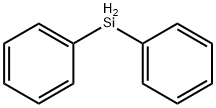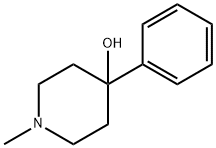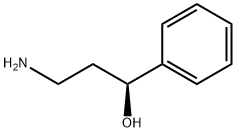Loperamide hydrochloride
Synonym(s):µ-Opioid Receptor Agonist, Loperamide Hydrochloride, Imodium;4-(p-Chlorophenyl)-4-hydroxy-N,N-dimethyl-α,α-diphenyl-1-piperidinebutyramide hydrochloride;Loperamide Hydrochloride - CAS 34552-83-5 - Calbiochem;LPM
- CAS NO.:34552-83-5
- Empirical Formula: C29H34Cl2N2O2
- Molecular Weight: 513.5
- MDL number: MFCD00058581
- EINECS: 252-082-4
- SAFETY DATA SHEET (SDS)
- Update Date: 2025-12-23 13:58:55

What is Loperamide hydrochloride?
Chemical properties
White Solid
Originator
Imodium,Janssen,UK,1975
The Uses of Loperamide hydrochloride
Loperamide hydrochloride is a Ca2+ channel protein inhibitor and MOR activator.
The Uses of Loperamide hydrochloride
Labeled Loperamide, which is used as an antidiarrheal
The Uses of Loperamide hydrochloride
Ca channel blocker
Definition
ChEBI: A hydrochloride obtained by combining loperamide with one equivalent of hydrochloric acid. Used for treatment of diarrhoea resulting from gastroenteritis or inflammatory bowel disease.
Indications
Loperamide hydrochloride (Imodium) structurally resembles both haloperidol and meperidine. In equal doses, loperamide protects against diarrhea longer than does diphenoxylate. It reduces the daily fecal volume and decreases intestinal fluid and electrolyte loss. Loperamide produces rapid and sustained inhibition of the peristaltic reflex through depression of longitudinal and circular muscle activity.The drug also possesses antisecretory activity, presumably through an effect on intestinal opioid receptors.
Manufacturing Process
23.6 parts of 2-oxo-3,3-diphenyl-tetrahydrofuranare melted at 100°C in an
oil-bath and gaseous hydrogen bromide is introduced into it during 3 hours.
The reaction mixture is cooled and triturated in benzene. The product is
filtered off, washed with petroleum ether and dried in an exsiccator, yielding
4-bromo-2,2-diphenylbutyric acid; MP 127.5%.
To a stirred suspension of 16 parts of 4-bromo-2,2-diphenylbutyric acid in 150
parts of chloroform are added dropwise 16 parts of thionyl chloride and the
whole is stirred and refluxed for 2 hours. The reaction mixture is evaporated,yielding 4-bromo-2,2-diphenyl-butyrylchloride as a residue.
60 parts of 4-bromo-2,2-diphenylbutyrylchloride are dissolved in 400 parts of
toluene and gaseous dimethylamine is introduced slowly into the solution
while cooling (temperature is kept at about 0°C). The introduction is ceased
when dimethylamine escapes from the cooler, and stirring is continued for 2
hours at ordinary temperature. The precipitated product is filtered off and
dissolved in a minimum quantity of water. The product is extracted with
chloroform. The extract is dried and evaporated. The residue solidifies on
triturating in 4-methyl-2-pentanone. The solid is filtered off and dried, yielding
dimethyl -(tetrahydro-3,3-diphenyl-2-furylidene)ammonium bromide; MP 169°
to 171.5°C.
A mixture of 6.33 parts of 4-(p-chlorophenyl)-4-piperidinol, 8 parts of sodium
carbonate, 0.2 part of potassium iodide and 240 parts of 4-methyl-2-
pentanone is distilled azeotropically. Then there are added 12.12 parts of
dimethyl-(tetrahydro-3,3-diphenyl-2-furylidene)ammonium bromide (from the
preceding step) and the whole is stirred and refluxed for about 15 hours. The
reaction mixture is filtered hot and the filtrate is evaporated.
The oily residue is dissolved in 2-propanol and to this solution is added an
excess of 2-propanol previously saturated with gaseous hydrogen chloride.
The whole is evaporated and the oily residue is warmed in diluted hydrochloric
acid solution. Upon the addition of toluene, the salt is precipitated. It is
filtered off, boiled in acetone, and filtered off again after cooling, yielding 4-
(p-chlorophenyl)-4-hydroxy-N,N-dimethyl-α,α-diphenylpiperidine-1-butyramide
hydrochloride; MP 222.1°C.
Indications
Loperamide hydrochloride is indicated for the control and symptomatic relief of acute nonspecific diarrhea and of chronic diarrhea associated with inflammatory bowel disease.It is also indicated for reducing the volume of discharge from ileostomies.
brand name
Imodium (Janssen); Imodium (McNeil).
Therapeutic Function
Antidiarrheal
Mechanism of action
Loperamide has the effect of reducing intestinal motility, reducing gastrointestinal secretions, and at the same time, increasing the tone of the anal sphincter. The drug also has the effect of prolonging the transit time through the intestinal mucosa, increasing the ability to transport fluids and electrolytes, and reducing the amount of stool. The effect is related to a decrease in the release of acetylcholine and prostaglandins.
Side Effects
Loperamide hydrochloride may cause serious side effects including:
diarrhea that is watery or bloody,
stomach pain or bloating,
ongoing or worsening diarrhea,
fast or pounding heartbeats,
fluttering in your chest,
shortness of breath, and
lightheadedness
General Description
Loperamide is an antidiarrheal agent used in controlling acute nonspecific diarrhea and chronic diarrhea associated with inflammatory bowel diseases.
Biological Activity
High affinity μ -opioid receptor agonist with peripheral selectivity (K i values are 2, 48 and 1156 nM for μ -, δ - and κ -opioid receptors respectively). Antidiarrhoeal and antihyperalgesic agent. Also a Ca 2+ channel blocker; at low micromolar concentrations it blocks broad spectrum neuronal HVA Ca 2+ channels and at higher concentrations it reduces Ca 2+ flux through NMDA receptor operated channels.
Biochem/physiol Actions
Loperamide hydrochloride (HCl) is a non-selective Ca2+ channel blocker. At nanomolar concentrations, it binds to μ-opioid receptors. Loperamide HCl does not cross the blood-brain barrier.
Mechanism of action
Loperamide also is a potent inhibitor of intestinal CYP3A4, increasing the intestinal absorption of other CYP3A4 substrates. The clinically significant drug interactions of loperamide with coadministered CYP3A4 and CYP2C8 substrates or inhibitors would be limited, however, because of its two metabolic pathways.
Pharmacokinetics
Loperamide is marketed as capsules (2 mg) and liquid (1 mg/5 mL) preparations. The recommended dose is 4 mg initially and an additional 2 mg following each diarrheal stool. The dose should not exceed 16 mg/day. It is too lipophilic to dissolve in water for an intravenous dosage form, a property that limits its abuse potential. The compound is highly lipophilic and undergoes slow dissolution, thus limiting the bioavailability of the agent to approximately 40% of the dose. Its low oral bioavailability also can be attributed to first-pass metabolism by both CYP2C8 and CYP3A4 to its primary N-demethyl metabolite. Peak plasma levels are reached in approximately 5 hours, with an elimination half-life of approximately 11 hours. Approximately 1% of the dose is excreted into the urine unchanged.
Clinical Use
Loperamide is effective against a wide range of secretory stimuli and can be used in the control and symptomatic relief of acute diarrhea that is not secondary to bacterial infection.
Side Effects
Adverse effects associated with its use include abdominal pain and distention, constipation, dry mouth, hypersensitivity, and nausea and vomiting.
Storage
Room temperature
Properties of Loperamide hydrochloride
| Melting point: | 223-225°C |
| Density | 1.1905 (rough estimate) |
| refractive index | 1.6100 (estimate) |
| storage temp. | 2-8°C |
| solubility | Slightly soluble in water, freely soluble in ethanol (96 per cent) and in methanol. |
| form | neat |
| pka | 8.66(at 25℃) |
| form | Solid |
| color | White to Almost white |
| Merck | 14,5571 |
| CAS DataBase Reference | 34552-83-5(CAS DataBase Reference) |
Safety information for Loperamide hydrochloride
| Signal word | Danger |
| Pictogram(s) |
 Skull and Crossbones Acute Toxicity GHS06 |
| GHS Hazard Statements |
H301:Acute toxicity,oral |
Computed Descriptors for Loperamide hydrochloride
Loperamide hydrochloride manufacturer
Attar Global
Jai Radhe Sales
Pharma Links
Festiva Pharma
New Products
Indole Methyl Resin tert-butyl 9-methoxy-3-azaspiro[5.5]undecane-3-carboxylate Boc-His(Boc)-OH 2-CTC Resin 4-Chloro-7-tosy1-7Hpyrrolo[2,3-d]pyrimidine 5,7-Dibromo-1H-indole 2,5-dichloro-N-hydroxy-4,6-dimethylpyridine-3-carboximidamide 2,2-Dimethoxy-7-azaspiro[3.5]nonane hydrochloride 4-chloromethyl-5-methyl-1,3-dioxol-2-one (DMDO-Cl) R-2-BENZYLOXY PROPIONIC ACID 1,1’-CARBONYLDIIMIDAZOLE 1,1’-CARBONYLDI (1,2-4 TRIAZOLE) N-METHYL INDAZOLE-3-CARBOXYLIC ACID 4-((2-hydroxyethyl)thio)benzoic acid 1-(TERT-BUTOXYCARBONYL)-2-PYRROLIDINONE Methyl 6-methylnicotinate 3-Pyridineacrylic acid tert-Butyl carbazate TETRAHYDRO-2H-PYRAN-3-OL 2-((4-morpholinophenylamino) (methylthio) methylene) malononitrile 3-(4-morpholinophenylamino)-5-amino-1H-pyrazole-4-carbonitrile 2,4-dihydroxybenzaldehyde 1,3-Diethyl-1,3-Diphenylurea Methyl 2-methylquinoline-6-carboxylateRelated products of tetrahydrofuran








You may like
-
 LOPERAMIDE HYDROCHLORIDE 1% DC GRANULES 98%View Details
LOPERAMIDE HYDROCHLORIDE 1% DC GRANULES 98%View Details
34552-83-5 -
 Loperamide CAS 34552-83-5View Details
Loperamide CAS 34552-83-5View Details
34552-83-5 -
 Loperamide Hydrochloride CAS 34552-83-5View Details
Loperamide Hydrochloride CAS 34552-83-5View Details
34552-83-5 -
 Loperamide Hydrochloride CAS 34552-83-5View Details
Loperamide Hydrochloride CAS 34552-83-5View Details
34552-83-5 -
 Loperamide hydrochloride CAS 34552-83-5View Details
Loperamide hydrochloride CAS 34552-83-5View Details
34552-83-5 -
 Loperamide hydrochloride CAS 34552-83-5View Details
Loperamide hydrochloride CAS 34552-83-5View Details
34552-83-5 -
 Loperamide hydrochloride CAS 34552-83-5View Details
Loperamide hydrochloride CAS 34552-83-5View Details
34552-83-5 -
 Loperamide Hcl Powder Manufacturer India, Grade Standard: Medicine GradeView Details
Loperamide Hcl Powder Manufacturer India, Grade Standard: Medicine GradeView Details
34552-83-5
